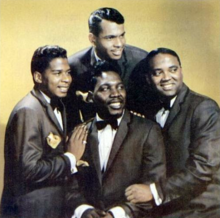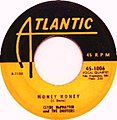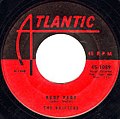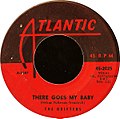The Drifters
The Drifters were an American rhythm & blues vocal group founded in 1953 , which was subject to strong staff fluctuations until its dissolution in 1978 and brought a total of five million-seller onto the market such as Save the Last Dance for Me . Despite their personal inconsistency, they belonged to the style-defining and changing groups of this musical style. From 1976 onwards, other groups were formed under the name Drifters, and they still perform today. Under the uniform group name Drifters hid at least four formations, whose single records were partially mixed as A and B side by the record company Atlantic Records .
Foundation phase
| Clyde McPhatter & the Drifters | |
|---|---|
| Founding: | 1953 |
| Resolution: | 1958 |
| Genre: | Rhythm & Blues , Doo Wop |
| Founding members | |
| Tenor singing : | Clyde McPhatter (until 1954) |
| Singing : | Willie Ferbee (1953) |
| Singing : | Andrew Thrasher (until 1955) |
| Singing : | Gerhart Thrasher |
| Other former members | |
| Singing : | Bill Pinkney (1953-1958) |
| Singing : | Johnny Moore (1954-1957) |
| Singing : | David Baughn (1954) |
| Singing : | Charlie Hughes (1955-1958) |
| Current or last occupation | |
| Singing : | Bobby Hendricks (from 1957) |
| Singing : | Jimmy Millender (from 1958) |
| Singing : | Tom Evans (from 1958) |
| Singing : | Gerhart Thrasher |
Lead tenor Clyde McPhatter sang with the rhythm & blues vocal group Billy Ward & His Dominoes since 1950 . With these McPhatter appeared as lead singer until April 1953. When Ahmet Ertegün of Atlantic Records went to a show with the Dominoes in the famous Birdland on May 6, 1953 , he found that the Dominoes had fired their lead singer McPhatter. Ertegün found McPhatter, had him put together a new vocal group and signed a record deal with him on May 7, 1953. The first recording session of Clyde McPhatter & The Drifters was scheduled for June 28, 1953. He hastily looked for suitable members from gospel groups, which he found in William "Chick" Anderson, David Baughn and David Baldwin (tenor) as the first formation of the new vocal group. After intensive rehearsals with Jesse Stone, the Drifters entered the recording studio for the first time, in which they were instrumentally accompanied by Sam "The Man" Taylor and Ben Webster (tenor saxophone), Jesse Stone (piano) and Mickey Baker (guitar). The four resulting recordings made it clear to the producer Ertegün that a new group had to be put together; because the quality was not enough for a successful publication. On the second recording date August 9, 1953, in addition to the lead tenor McPhatter, Bill Pinkney (bass baritone or tenor), Andrew "Bubba" Thrasher (second tenor), brother Gerhart "Gay" Thrasher (baritone) and Willie Ferbie (bass) appeared a completely new composition Group. It was one of the first recording sessions that Ertegün and Jerry Wexler appeared as producers. Five titles were the result, of which Money Honey was published in September 1953, topped the R&B charts for eleven weeks and sold two million copies. Even the B-side Lucille - from the first session on June 28, 1953 with completely different group members - still reached position 7 on the R&B charts . The personal basis for a successful record career seemed to have been found.
The 1950s
The third session took place on November 12, 1953, from which the wild Such A Night stood out as a potential hit with four more titles . Again, four shots were preserved from the fourth session of 4 February 1954 including the calypso-like Honey Love , an extraordinary version of White Christmas and the boogie-woogie Watcha Gonna Do . McPhatter delivered passionately intense and believable recordings. His soulful intonation in combination with melodic understanding were unique. The fifth and sixth sessions on March 14, 1954 and October 24, 1954, respectively, did not produce any hit material.
In the meantime, McPhatter had been drafted into the army in May 1954, but was still able to take part in intake sessions because he was stationed in the USA ( Buffalo / New York). At the same time, he had sold his 50% stake in the name of the group to the manager George Treadwell , so that the latter now fully controlled the group name through The Drifters Inc. After his release, McPhatter started a solo career in July 1955, which began with Atlantic Records on August 25, 1955 with Seven Days . This was followed by a duet with Ruth Brown on August 29, 1955 and the song Love Has Joined Us Together . On April 19, 1956, he was released from the army.
The vacant position of lead tenor at the Drifters was filled in April 1955 with Bobby Hendricks as the sixth lead tenor, tenor Johnny Moore was also new. In this constellation, five tracks were created on September 19, 1955 in Los Angeles, of which Adorable (written by Platters manager Buck Ram ) and the 16-bar blues Ruby Baby (written by Leiber / Stoller ) should be mentioned. At that time, Atlantic Records signed a production contract with Leiber / Stoller, which also gave them musical access to the Drifters. You wrote for the Drifters in particular Fool's Fall in Love and Drip Drop , they wrote a total of eight titles for the Drifters. Charly Hughes replaced Andrew Trasher and Tommy Evans replaced Bill Pinkney. The high staff turnover was certainly the main reason for the low success of the group between December 1955 and August 1958, because in the summer of 1957 Moore and Hughes were drafted into the army. which required new staff and a changed musical orientation. By May 1958, the Drifters had 13 chart hits.
In the session on April 28, 1958, under Leiber / Stoller production management for the first time, the Drifters (in the formation Bobby Hendricks, Gerhart Thrasher, Jimmy Millender and Tommy Evans) recorded Drip Drop , among others ; However, Hendricks had left the group a week later. The Drifters were thus without a lead singer when their appearance in the Apollo Theater was due on May 30, 1958. Hendricks decided, at the request of the manager George Treadwell, to perform this performance as lead singer. The group has been without a hit for over a year. Manager Treadwell listened to the first The Crowns and was so convinced of their performance that he asked them backstage if they could take on the role of the new Drifters. Due to their acceptance, he fired the previous Drifters completely immediately after their appearance.
| Ben E. King & the Drifters | |
|---|---|
| Founding: | 1955? as The Five Crowns |
| Resolution: | - |
| Genre: | Doo-wop , rhythm and blues |
| Founding members | |
| Singing : | Elsbeary Hobbs (until 1958) |
| Singing : | Charlie Thomas |
| Singing : | Doc Green |
| Other former members | |
| Singing : | Ben E. King (1958–1961) |
| Singing : | Rudy Lewis (1961-1964) |
| Current or last occupation | |
| Singing : | Johnny Moore (from 1964) |
| Singing : | Charlie Thomas |
| Singing : | Doc Green |
However, it took until March 6, 1959 for the first recording session of the new Drifters with the line-up of Ben E. King (lead tenor), Charlie Thomas (tenor), Doc Green (baritone) and Elsbeary Hobbs (bass). With the hypnotic There Goes My Baby , not composed by Leiber / Stoller , the producers brought the Drifters back to success, because Wexler expected better crossover successes on the pop market. The conditions for this were not good. The rhythm & blues sound of the song was backed on March 6, 1959 in the Coastal Studios with four violins and a cello, arranged by Stan Applebaum. “You can't use violins with the Drifters,” was the unspoken motto in the music industry. Chief producer Jerry Wexler was horrified: "That sounds like two radio stations overlapping" and initially didn't want to publish the song. After great resistance it was released in May 1959 - the single became the next million seller. Leiber / Stoller backed most of the upcoming Drifters songs with violins and also with Latin American rhythms such as rumba , samba or tango , previously unthinkable and experimental in rhythm and blues. In the Bell Sound Studios was among others on December 23, 1959 This Magic Moment with a rumba rhythm.
The 1960s
Atlantic Records successfully positioned lead singer Ben E. King as a soloist, and his position with the Drifters was replaced in September 1960 by Rudy Lewis. With the million-seller Save the Last Dance For Me (arranged by Stan Applebaum ), which was created on May 19, 1960 and published in June 1960 , the Drifters achieved their only number one in the pop hit parade and the international breakthrough, the zenith of their career was reached.
In the session on February 1, 1961 with the new lead tenor Rudy Lewis, the authors Doc Pomus / Mort Shuman were represented with Room Full of Tears and Sweets for My Sweet , Please Stay was composed by Burt Bacharach / Bob Hilliard and Some Kind of Wonderful came from From the pen of Gerry Goffin / Carole King . The July 13, 1961 session presented the Gospelaires as a background choir with Cissy Houston, Doris Troy , Dee Dee Warwick and their sister Dionne Warwick . All of them, especially Dionne Warwick, would later embark on an impressive solo career. It is rumored that Bacharach discovered Dionne Warwick during this session. From the recording session on June 28, 1962, Up on the Roof , a composition by Goffin / King, emerged. The song describes the urban restlessness, after which everyday worries only vanish on the roof. Barry Mann / Cynthia Weil were responsible for On Broadway , created on January 22nd, 1963 , the ninth recording session for Leiber / Stoller as a producer for the Drifters, whose text is about young people who dream of stardom on Broadway. Phil Spector plays a guitar obligato here . With the 13th session on August 22, 1963, Leiber / Stoller ended their production job. Bert Berns followed as producer on December 12, 1963.
When the lead tenor Rudy Lewis died unexpectedly of his drug addiction, a recording session had to be postponed by one day to May 21, 1964 so that Johnny Moore could step in as a replacement. Still impressed by the death of their lead singer, the Drifters presented Under the Boardwalk . From October 22, 1964, Tom Dowd produced briefly , including the November 10, 1964 session, in which a Drifters album was created for the first time. The previous LPs were only compilations of the single hits. Berns produced until July 26, 1966. In this phase Johnny Moore was involved, who as lead singer had to cope with ten changes of group members.
Her long-time manager George Treadwell, who was mostly responsible for the change in personnel, died on May 14, 1967. His wife Faye took over the job, but until the end of the record deal with Atlantic Records in 1972 there were no more hits. Ain't It the Truth (May 5, 1967; last note on the R&B charts at number 36), Still Burning in My Heart (January 1968), Steal Away (March 10, 1969), You Got to Pay Your Dues (April 24, 1970) or A Rose By Any Other Name (January 5, 1971) were all unsuccessful. Between 1959 and 1966, the Drifters achieved 21 top 10 hits in the pop and R&B charts, including three million-sellers, made possible by a number of ambitious authors from the Brill Building such as Goffin / King, Mann / Weil, Pomus / Shuman or also Burt Bacharach / Hal David. The Drifters' repertoire represented the who's who of pop composers. When the group split again, Pinkney gathered a group that had previously performed as The Tears . Benny Anderson, George Wallace, Albert Fortson and Mark Williams became the Original Drifters with Pinkney .
The 1970s
Faye Treadwell moved with the Drifters to England, where they received a new recording contract in October 1972 with Bell Records - the British subsidiary of Atlantic Records. She hired the most successful British producers like Roger Greenaway and pop songwriters like Geoff Stephens , Tony Macauley and Barry Mason to reactivate the group that had been forgotten. Six - albeit British - top 10 hits were the result. The first record of the ten singles on Bell was Everynight (October 1972; Bell # 1269), then Like Sister and Brother (# 1313; June 1973), Kissing in the Back Row of the Movies (# 1358; May 1974) was the best with number two in Great Britain, There Goes My First Love (# 1433; July 1975), Can I Take You Home Litte Girl (# 1462; November 1975), last record was Every Nite's A Saturday Night With You (# 1491; August 1976 ). From November 1976 they were under contract with Arista Records , where they stayed until July 1978. Subsequent singles on other labels were remakes of already released singles.
Litigation over the group name
The Drifters were actually at least four different groups, which were headed by a total of 12 different lead singers from 11 other vocal groups between 1953 and 1971. External factors such as the army, drug use or family problems were often the cause of the change in staff. The name secured by manager George Treadwell was retained, as was the record company, the core of the session musicians and the production staff for 20 years. The fluctuations also bothered the label, because it was not easy to present an unchanged group name to the public, although none of the founding members sang along.
This situation was exacerbated when from 1976 at least two groups appeared in parallel under the name Drifters. The music market was confused about the various groups that were meanwhile touring or making records as Drifters or Original Drifters . In each of the groups there was at least one member of the original Drifters. Since Faye Treadwell had inherited the rights to the name from her late husband and was staying with her Drifters in England, she was sued for injunctive relief by other American groups of the same name. The cited federal court in Newark, New Jersey found that George Treadwell's trademark rights to the group name had remained unchanged since April 1954, when he gained sole ownership and control of the name. The name rightfully belongs to The Drifters Inc. , a company now owned by Faye Treadwell. Uninterrupted royalties on records with the name Drifters established a permanent commercial right to use the name, according to the judgment. The Drifters registered by other interested parties in December 1976 had therefore been registered with fraudulent intent.
This judgment, confirmed by an appeals court on February 9, 2001, was groundbreaking also in international law with regard to the use of stage names when there is a high risk of confusion. The trials revealed how far Treadwell's control of the Drifters went. The members of the group were employees of The Drifters Inc. , from which they received a weekly wage, the company decided on staff changes, selected the music and arrangements and monitored record contracts and performances. The Drifters were legally aptly defined as a "protected trademark with constantly changing members". This was followed by a series of counter-lawsuits, which on September 7, 2007 reached identical judgments.
Statistics and honors
If you look at the heterogeneous composition of the groups during their time at Atlantic Records, formally and musically as a unit, the Drifters have recorded a total of 124 tracks within 20 years. They put 36 tracks in the rhythm & blues charts, 23 of which made it into the pop hit parade as a crossover. While they took first place five times in the R&B charts, they only managed to do so once in the pop hit parade. In the 35 years of existence, no fewer than 57 singers have belonged to the group. Until 1970 there were 12 lead singers. Of these, Johnny Moore sang 53 titles in this capacity as lead singer most often (42.7% of all titles). Clyde McPhatter had 19 tracks (or 15.3% of all recordings), Rudy Lewis 18 (14.5%), the much better known lead singer Ben E. King only sang 11 tracks (8.9%) as lead tenor.
In the United States, three versions of the Drifters toured the country at times. A formation that holds the rights to the name and succeeds lead singer Johnny Moore, who died on December 30, 1998, but has no members from the 1950s or 1960s . A second formation around bass singer Bill Pinkney (member of the first formation from 1953 to 1956), which he founded in 1958 and calls itself "Bill Pinkney's Original Drifters". There is also a third group of Charlie Thomas (member of the second formation from 1958 to 1967), who appear as "Charlie Thomas' Drifters".
In 1988 he was inducted into the Rock and Roll Hall of Fame . On July 4, 2007, the 81-year-old Bill Pinkney, who was best known for his distinctive bass voice on the Drifters hit single White Christmas , died as the last member of the first line-up from the 1950s. Ben E. King died on April 30, 2015. Thus, Charlie Thomas, only one of the original members of the second line-up from the 1960s, is currently alive.
The Rolling Stone listed the Drifters ranked 81 of the 100 greatest players of all time .
Cliff Richard & the Drifters
Cliff Richard's longtime backing band, The Shadows , was called The Drifters when it was first released between August 1958 and July 1959 . Under pressure from George Treadwell, they were renamed Shadows .
Discography
Studio albums
| year | title |
Top ranking, total weeks, awardChart placementsChart placements (Year, title, rankings, weeks, awards, notes) |
Remarks | ||
|---|---|---|---|---|---|
|
|
|
|
|||
| 1964 | Under the boardwalk | - | - |
US40 (22 weeks) US |
|
| 1965 | The Good Life with the Drifters | - | - |
US103 (6 weeks) US |
|
| 1975 | Love Games | - |
UK51 (1 week)UK |
- | |
More studio albums
|
|
literature
- Bill Millar: The Drifters. The Rise And The Fall Of The Black Vocal Group . Studio Vista Ltd., London 1971.
- Tony Allan, Faye Treadwell: Save The Last Dance For Me. The Musical Legacy Of The Drifters 1953-1993 . Popular Culture, Ann Arbor / Mich. 1993, ISBN 1-56075-028-6 .
Web links
- Detailed biography of Marv Goldberg
Individual evidence
- ↑ The name came from the fact that all group members had changed from other vocal groups, and should have an impact on the future.
- ^ Charlie Gillett, Making Tracks: The Story of Atlantic Records , 1988, p. 93.
- ^ Joseph Murrells, Million Selling Records , 1985, p. 78.
- ↑ Bill Millar: The Drifters. The Rise And The Fall Of The Black Vocal Group , London 1971, p. 111.
- ↑ The Twist by Chubby Checker was derived from this, but Atlantic Records did not want to push itself to the fore with a plagiarism lawsuit
- ^ Charlie Gillett, Making Tracks: The Story of Atlantic Records , 1988, p. 95.
- ↑ Bill Millar: The Drifters. The Rise And The Fall Of The Black Vocal Group , London 1971, p. 50.
- ^ Jay Warner, American Singing Groups , 2006, p. 162.
- ↑ Bill Millar: The Drifters. The Rise And The Fall Of The Black Vocal Group , London 1971, p. 60.
- ↑ Jerry Leiber / Mike Stoller with David Ritz, Hound Dog - The Leiber and Stoller Autobiography , 2009, p. 161.
- ^ Obituary in the Los Angeles Times .
- ↑ Composed by Paul McCartney .
- ^ Jay Warner, American Singing Groups , 2006, p. 159.
- ↑ Bill Millar: The Drifters. The Rise And The Fall Of The Black Vocal Group , London 1971, p. 51.
- ^ Drifters' Manager Wins Right to Continued Use of Name - Civ. No. 95-3794, USDC, NJ, July 30, 1999 in: Business Wire August 6, 1999 ( Memento July 8, 2012 in the web archive archive.today ).
- ↑ MARSHAK v. TREADWELL NO. CIV. 95-3794 (NHP). - UNITED STATES DISTRICT COURT, DISTRICT OF NEW JERSEY .
- ↑ Bill Millar: The Drifters. The Rise And The Fall Of The Black Vocal Group , London 1971, p. 65.
- ↑ Bill Millar: The Drifters. The Rise And The Fall Of The Black Vocal Group , London 1971, p. 110.
- ↑ Rock and Roll Hall of Fame: The Drifters in the Rock and Roll Hall of Fame.
- ↑ 100 Greatest Artists of All Time. Rolling Stone , December 2, 2010, accessed August 8, 2017 .
- ↑ Chart sources: Singles1 Singles2 Albums UK Billboard 200
- ^ The Billboard Albums by Joel Whitburn , 6th Edition, Record Research 2006, ISBN 0-89820-166-7 .








